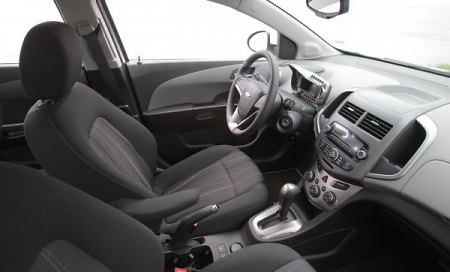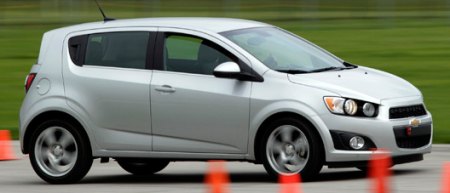Daewoo is dead, so are
Matiz, Kalos, Lacetti and Tosca. In January this year, General Motors
renamed its Korean
subsidiary from GM Daewoo to GM Korea,
cutting the last tie with Daewoo group. Within a few months, all cars
rolled off the production line had switched to Chevrolet badges. Now
Chevrolet finally becomes a global brand, something no one could
imagine just 5 years ago. Nevertheless, the rise of Chevrolet does not
mean the fall of the Korean subsidiary. On the contrary, GM Korea is
increasingly important to GM. Last year, it supplied
more than 1.7 million Chevrolet-badged cars and small SUVs to the rest
of the world, contributing to 40 percent of the American brand's total
sales. Moreover, it takes the lead of developing GM's global small car
platform, Gamma II. The first fruit is Chevrolet Spark. The second is
this one, Chevrolet Aveo.
The Aveo is otherwise known as Sonic in the USA market. GM originally
wanted to harmonize its name globally. This is evident from the fact
that the earliest US press releases used the Aveo name. However,
because the last generation Aveo did not give American a fond memory,
marketing eventually drove to adopt a new name, Sonic. I wonder why
other markets have no such concern.
As before, the Aveo is a B-segment vehicle available in two body forms,
5-door hatchback and 4-door sedan. Both get a generous wheelbase of
2525 mm, longer than its key rivals Ford Fiesta, Honda Fit (Jazz) and
Volkswagen Polo. Not only wheelbase, the car has grown in all
dimensions, making it one of the roomiest cars in class. Cheap
Korean production cost always bring us more metal for money.
The underpinning Gamma II platform brings no surprises. It follows the
class norm to adopt MacPheson struts up front, torsion-beam suspension
at the rear, electric power steering and increased use of
high-strength steel in the monocoque. Equipment is up to date. Standard
features include stability control, cruise control, 6 air bags (10 for
America !), iPod connectivity, automatic engine stop and start,
6-speed automatic gearbox… which mean quite
complete.
Styling is quite satisfying too. The Korean design looks bold and
sporty, thanks to
large wheel arches, rising waistlines, a prominent grille and a heavily
sculpted bonnet. Quad-round headlights give it an unusual character and
reminds me the earlier BMW designs. The hatchback adopts "hidden" rear
doors, a fashionable feature these days. Unfortunately, they don't look
quite hidden, blame to the prominent door frame and a large
piece of black plastic that holds the door handle. Still, the
hatchback is better looking than the slightly conservative sedan.
Unless you
really need those 506 liters of boot and the rear seats simultaneously,
I would recommend the hatchback.
In the cabin, you get enough space for four six-footers, or 5 at a
squeeze. The ambience at the rear seats is somewhat claustrophobic due
to the high waist line, though it's not uncommon in modern cars. Up
front, the driver is served with a steering wheel that is adjustable
for reach and rake, so finding a comfortable driving position is easy.
As in Spark, facing the driver is a small, motorcycle-inspired
instrument binnacle. It challenges human brains by incorporating an
analogue rev counter and a digital speedometer, so every time you turn
your vision from one to another you will need a while to recalibrate
your mind before understanding the readings. How silly it is ! Equally
unremarkable is the lack of quality feel, as the whole dashboard and
door panels are made of shinny hard plastic that is prone to scratch.
It falls a long way behind Polo and Fiesta. In contrast, the
switchgears on center console look and feel much better, as many of
them come from Opel Astra and Insignia.

Aimed as a global product, the Aveo is offered with a variety of
powertrains. Most markets get a trio of small Ecotec engines engineered
by Opel. They displace 1.2, 1.4 or 1.6 liters and produce 86hp, 100hp
and 115hp respectively. All are equipped with DOHC 16 valves and dual
continuous VVT. Despite this, they are neither particularly punchy nor
quiet, just about class average. In Europe, the petrol is supplemented
with Fiat's 1.3-liter Multijet turbo diesel with either 75hp or 95hp.
In the United States, more powerful engines are used instead: 1.8-liter
Ecotec with 140hp and 123 lbft and 1.4-liter turbo with the same
horsepower but 148 lbft of torque from as low as 1850 rpm. Both are
taken straight from the
larger Chevrolet Cruze, so the Sonic should offer class-leading
performance, especially in the form of 1.4T with 6-speed manual
gearbox. A pity it has no intention to offer a hot hatch version like
Ford Fiesta ST or VW Polo GTI.

Just like most other Chevrolets built by GM Korea, the Aveo / Sonic is
not exactly a driver's car. Dynamically it is only average. Which is to
say its handling, no matter in terms of steering, agility, body control
and resistance to understeer, is no match with Fiesta or Polo. But it's
not too bad either. The car is designed to be easy to drive, with light
steering, smooth gearchange and well-weighted controls. The roomy
cabin, large doors and good visibility add to its easy-going manner.
Unless on poor roads, ride quality is generally smooth. Refinement at
motorway cruising is okay provided you can skip the least powerful
engine.
Rivals from Ford, Volkswagen and Honda are still some way better than
the latest challenger from GM. However, taking price and equipment into
the equation, the latter is still worth considering, at least to those
putting driving dynamics on low priority.